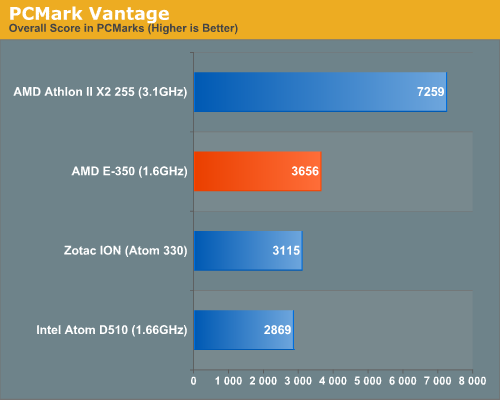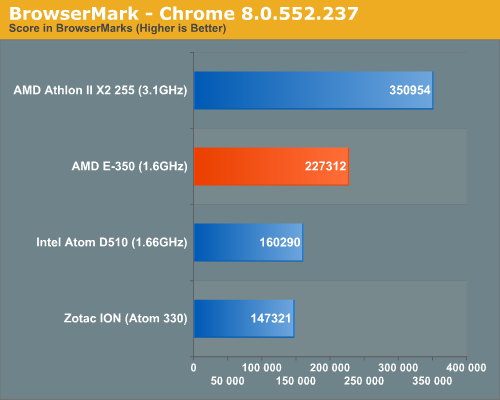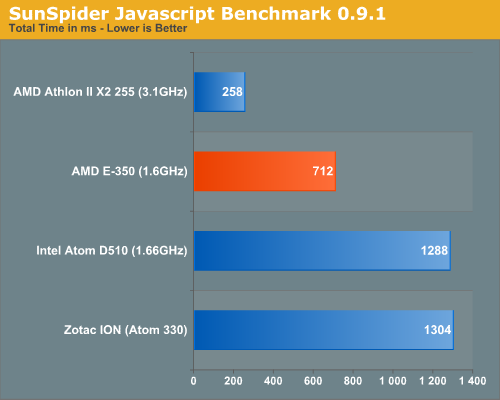The Brazos Review: AMD's E-350 Supplants ION for mini-ITX
by Anand Lal Shimpi on January 27, 2011 6:08 PM ESTGeneral Performance: In Between Atom and Athlon II
Atom may be efficient and fast enough to run a smartphone OS, but it absolutely chugs on Windows 7. The seat of the pants feel of an AMD E-350 is noticeably better. Single threaded performance, as you’ll soon see, is easily twice that of a similarly clocked Atom. Bobcat is still a dual-issue dual-core machine so high IPC or highly threaded workloads will show little difference between it and Atom. Thankfully, for most entry level netbook/nettop workloads Bobcat’s architecture should be sufficient. Before we get to the more CPU intensive tests I wanted to run through some reader requests for performance characterization.
I’ll start out with PCMark Vantage. There’s very little that separates PCMark from SYSMark in terms of how realistic the workload is. Neither suite is particularly representative of what an average user does today. What these suites are good at is being very long, and stressing enough aspects of a platform to give you a general idea of performance. SYSMark tends to focus on the more heavy user/content creation side of things (optimized for no more than 2 cores), while PCMark Vantage is much lighter test.
Looking at SYSMark you’d see no performance difference between the E-350 and Atom. The reason is simple. SYSMark was designed to be a modern day CPU benchmark. Most of the workloads exhibit high IPC and thus Bobcat’s front end acts as a bottleneck.
While SYSMark can be useful in estimating how a processor might handle particular heavy workload, it’s not useful in characterizing the sort of light workloads that you’d see a netbook or nettop user creating. PCMark Vantage is a collection of far simpler tasks. Again not specifically what you’d do today, but lighter nevertheless.
I compared four systems using PCMark Vantage, all with the same memory and I/O configuration. I dusted off an Atom 330 + ION motherboard from Zotac, an Atom D510, the MSI E-350 board and an Athlon II X2 255 on an 890GX motherboard. I picked the Athlon II simply because it’s a very affordable (~$65) modern day dual-core CPU. The Athlon II will help put the E-350’s performance compared to modern day x86 cores in perspective.

The E-350 holds a clear advantage over the Atom D510. The overall suite runs 27% faster on the E-350 than the D510, and even 17% faster than ION (the overall suite includes some GPU tests where ION makes up for Atom). The advantages vary from 10 - 80% in most cases. If you look at tests where the GPU is involved, you have to start counting how many times Brazos is faster than Intel’s current Atom platform.
I have to put the E-350’s dominance in perspective however. An Athlon II X2 255 still delivers nearly 2x the performance of the E-350 in PCMark Vantage. Just as the Atom to E-350 jump is noticeable, so is the jump from an E-350 to an Athlon II.
A performance advantage in PCMark is often difficult to visualize so let’s move on to some more application specific tests. Next up are two web browser benchmarks we typically use in our smartphone reviews: BrowserMark and SunSpider.
BrowserMark is a general purpose browser test. Rather than loading full web pages it tests rendering speed for commonly used components of web pages and presents one gigantic score at the end to tell you which platform is faster. The benchmark is obviously browser dependent so I ran all numbers on the same version of Chrome (8.0.552.237). The test platforms were the same as before:

The E-350 holds a 41% performance advantage over the Atom D510 here. That’s definitely enough to be noticeable in actual usage. In general web browsing is noticeably faster on Brazos than on Atom. The Athlon II is another 50% faster than the E-350. Again, it’s enough to be noticeable.
SunSpider is a collection of javascript benchmarks that we typically run to compare smartphones. It ends up being a good way to compare one aspect of web browsing performance between these entry level platforms.

The Brazos advantage over Atom actually climbs when we look at pure js performance. The E-350 is 80% faster than the Atom D510 here. The Athlon II advantage grows as well. Web browsing can be very CPU bound at times.
Brazos, like Atom, will never compete with its bigger brothers. There’s only so much you can do with a very tiny die. What AMD’s platform does provide however is a stepping stone between Atom and the lower end beefy x86 cores, which is something we’ve needed.
Many of you wanted even more real world testing, focusing on things like application launch time and system boot time. Ask and you shall receive is one of our policies around here (within reason) so I put together a drive image with a ton of applications, games and data. I measured the time it took to boot to the Windows 7 desktop as well as timed individual application launches.
Boot time is a difficult thing to compare between platforms. Everything from BIOS optimizations to the type of video card you have in the system can impact boot time. In this case, the E-350 system managed to boot 13% faster than the Atom system.
Individual applications, specifically light weight apps (e.g. Google Chrome, Media Player Classic), launch relatively quickly on both Atom and Brazos. This is largely due to the fact that I’m testing with an SSD. Regardless there’s still no appreciable difference in launch time between the platforms when the drive bottleneck is removed (the difference doesn’t grow as you add bottlenecks in). Where we see the E-350 really shine is in the larger, more complex applications and games.
| Application Launch Time Comparison | |||||||||||
| Platform | Boot Time (POST to Desktop) | Adobe Reader 9 | IE8 | Chrome | MPC-HC | Cinebench 11.5 | Sonar 8 | CoD: Black Ops | Starcraft II | ||
| AMD E-350 (1.6GHz) | 61.5s | 2.2s | 1.4s | 1.4s | 1.2s | 5.5s | 8.8s | 15.0s | 21.9s | ||
| Intel Atom D510 (1.66GHz) | 70.3s | 1.5s | 1.4s | 1.4s | 1.2s | 3.9s | 10.3s | Fail | 39.8s | ||
| AMD Athlon II X2 255 (3.1GHz) | 53.8s | 1.0s | 0.8s | 0.7s | 0.7s | 2.5s | 4.5s | 5.3s | 9.9s | ||
Sonar 8 launched 17% faster on the E-350 vs. Atom, while Starcraft II launched in almost half the time of the Atom D510 (although I suspect part of the advantage there is GPU related). Not all application launches were faster on the E-350. Occasionally applications would launch faster on the D510, but that seemed to be the exception rather than the rule. Overall system performance is naturally faster on Brazos compared to Atom.
Bring the Athlon II into the picture and things look different. You can cut most of Brazos’ launch times in at least half to get an idea of the Athlon II’s performance.










176 Comments
View All Comments
djfourmoney - Thursday, January 27, 2011 - link
You can build a sub-$350 HTPC with this! If you can recycle some parts from any of your other builds you might be able to get it under $300. I built a ASRock based HTPC based on the price expected for that board ($110) and it comes in at $319 before taxes and shipping. Careful shopping might avoid that.Run Mediabrowser with TV and GameTime! Plug-ins.
You can now throw away your Cable Box SD or HD. If you have standard cable, turning in your box and building a HTPC around one of these boards will pay for itself in about a year.
If you get HD and Premium Channels, hopefully SiliconDust's 3 Tuner CableCard adapter will be out before NFL Training Camp.
For Direct TV/Dish Network/AT&T U-verse, you'll be able to use Hauppauge Colossus with Component Input, eliminate issues with the HD-DVR USB version. As long as they don't cripple the component output, there's no PQ difference.
Khato - Thursday, January 27, 2011 - link
I've been somewhat disappointed with the lack of actual investigation into how changes in memory bandwidth affect this new generation of integrated GPUs - both on Brazos here as well as Sandybridge earlier. The direct comparison to a 5450 here is interesting, but since it wasn't stated I'm guessing those were stock 5450 numbers, not a 5450 underclocked to be the same frequency core/memory?The primary reason for it being a point of interest is that the current rumor has Llano at anywhere from 4x to 6x the shader resources, but only 2.4x the potential memory bandwidth. More likely 2x in any actual systems though given that anything above DDR3 1333 carries a decent premium. So if Brazos is already seeing hints of memory bandwidth limitations...
Anand Lal Shimpi - Thursday, January 27, 2011 - link
Those were stock 5450 numbers, and you are correct - memory bandwidth is an issue (one of Sandy Bridge's "tricks" is the shared L3 cache, it helps mask memory bandwidth limitations quite well as it is currently used for Z operations among other things). I expect that Llano will be much quicker than the E-350, remember that in many cases we're not necessarily GPU bound but rather CPU bound in these game tests.I will continue to play with performance on Brazos but I expect that once I've got Llano in house I'll be able to get a better idea of how bad the memory bandwidth limitations actually are.
Take care,
Anand
Khato - Friday, January 28, 2011 - link
Thanks for the reply. The CPU vs GPU bound comment actually sparked another point of curiosity - how does the performance picture change as resolution increases?There are quite a few games where the performance increase going from integrated to either the 5450 or 5570 is basically the same, implying that it's CPU limited and something about the integrated graphics decreases the performance. The unknown being whether that something is a constant, a slight latency hit due to whatever arbitration scheme is used between CPU and graphics for example, or if it will scale with the load placed upon the GPU, as would be the case for memory bandwidth.
This certainly has me looking forward to at last getting to see how Llano graphics performance is in a few months. I'd find it all too amusing if the better integration in Sandybridge resulted in graphics performance on par with a memory constrained Llano.
bjacobson - Saturday, January 29, 2011 - link
I was thoroughly surprised the e350 coped as well as the dedicated cards using shared RAM.Was not expecting that.
Speed3mon - Thursday, January 27, 2011 - link
this comment... kinda gay.. sry but trueAloonatic - Friday, January 28, 2011 - link
I don't think that even the staunchest homophobe would even go as far as to associate being gay with the nonsense that the OP wrote.It'[ a shame that there isn't a store that fanboys have to shop in, where their beloved companies can rip them off royally, as that seems to be their want.
His comment wasn't gay, it was just sad, and ill-conceived, which might be how their parents probably view them too, in hindsight :o)
etudiant - Thursday, January 27, 2011 - link
The Zacate die size is comparatively minute at 75mm2, about a quarter the size of the Thuban.That translates to perhaps one twentieth of the manufacturing cost, given yields are much better for smaller die. Should be very helpful for AMD if they can deliver in quantity.
GeorgeH - Thursday, January 27, 2011 - link
I'm very impressed. Does anyone have an idea when Intel and VIA might respond with updated products?Anand Lal Shimpi - Thursday, January 27, 2011 - link
Intel's 32nm Atom refresh will appear in Q4 2011.Take care,
Anand